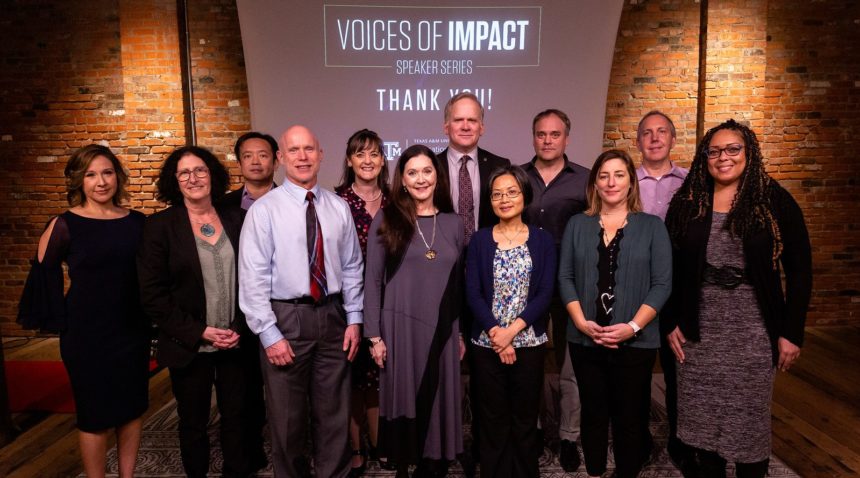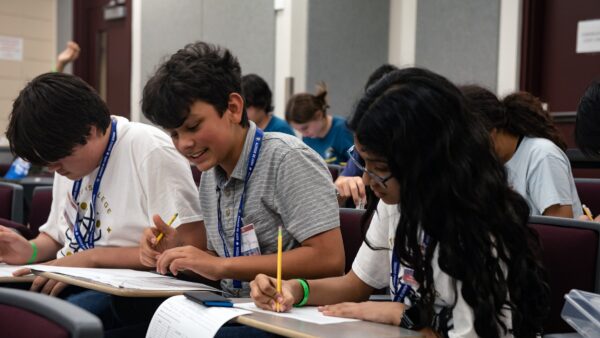Texas A&M College Of Education Shares Voices Of Impact
Twelve faculty experts were each given five minutes on Thursday to share their work with community members at the College of Education & Human Development‘s Voices of Impact event.
Now in its fourth year, the goal of the event is for faculty members to talk to everyday people about their areas of expertise in a way that everyone can understand, said Dean Joyce Alexander. The idea, she said, was for the audience at The Icehouse on Main in Downtown Bryan to learn about work at the college, which includes more than just education.
The wide variety of talks related to education, health and inspiration were reflective of the college’s goal to transform lives.

Steve Martin, “Life In The Fire Service”
One of the most dangerous jobs in the world belongs to the firefighters who put their lives on the line every time they answer an emergency call, said Clinical Associate Professor Steve Martin. But of the five U.S. firefighters who died during their work shifts in December, none died during an actual emergency call.
Martin said they had suffered massive heart attacks – something the FITLIFE Exercise and Clinical Testing Program aims to screen for. He said heart attacks were the leading cause of on-duty deaths from 1977 to 2016.
The job’s energy demands place a tremendous amount of stress on firefighters’ hearts, Martin said, increasing their risk for cardiovascular events if certain risk factors for heart disease like high blood pressure and obesity aren’t managed.
Martin serves as the program coordinator for the FITLIFE lab, which works to identify firefighters who may be at an increased risk for developing heart disease. The lab performs more than 300 cardiographs and screenings annually for the Bryan and College Station fire departments.
Through the lab, students take what they learned in the classroom and apply it in the real world, serving as the technicians performing the majority of the cardiovascular screening procedures.
Cancer surpassed heart attacks in 2016 as the leading cause of firefighter deaths. Martin said they face a 9 percent increase in cancer-related diagnoses and a 14 percent increase in cancer-related deaths when compared to the general population due to the toxins they inhale long after a fire is extinguished. With this in mind, Martin’s lab is now working with Baylor Scott & White and CHI St. Joseph Health to try to detect cancer early using ultrasound technology and a variety of blood tests.
During the first year of tests, two firefighters diagnosed with cancer had successful surgical procedures and were able to return to work in the same year due to early detection.

Tamika Gilreath, “Stressed In School: Military-Connected Kids”
Tamika Gilreath, an associate professor in health and kinesiology, shared her research on the experiences of military-connected children – those who have an active-duty parent.
With nearly 1 million military-connected kids in the U.S., 60 percent of them are school aged. About 80 percent of those attend public schools. While military kids are resilient, Gilreath said, they have to sacrifice time with parents, who may come back from their deployments different, either physically or emotionally. Military-connected kids also change schools nine times on average throughout their K-12 careers.
“I wondered what was going on with kids that were in public schools. A lot of us weren’t aware that so many of our military-connected kids were attending our civilian schools,” Gilreath said. “There were a few other researchers who had the same interest as me, and over several years we collected data from kids and schools in Oceanside, California outside of Camp Pendleton.”
Gilreath said the research showed some “troubling things.” Military-connected kids in seventh, ninth and eleventh grade more likely to report substance abuse than their civilian peers. They were also more likely to be bullied and report psychological distress. In response to the findings, Gilreath said school social workers and counselors were sent to the partner school districts, and the schools also started celebrating military life and culture so those children could feel connected and welcomed.
Through additional data she collected through 24 interviews with children ages 12-17, Gilreath found that kids with negative behaviors reported things like substance abuse and emotional issues, and they said negative experiences with other military-connected kids and bullying were their primary stressors.
Gilreath said she wants to answer whether military-connected children in Texas are having the same experiences as those that she found in California.

Steven Woltering, “Noisy Brains”
Steven Woltering, an assistant professor in the Department of Educational Psychology, is the director and founder of the Neurobiological lab for Learning and Development (NLD), which promotes and educates on the use of biometrics in social and health sciences.
As a neuroscientist, Woltering said he wondered if people with Attention-Deficit Hyperactivity Disorder (ADHD) had “noisier” brains. After an experiment, he found something interesting – the brains of people with ADHD are actually less “noisy” than the brains of the normal controls.
To explain this, Woltering presented an analogy of a brain in a checkerboard environment with the goal of getting to the top of a hill. One brain is programmed to move forward, backward, to the left or to the right, and knows to move in the direction that has the higher elevation. A second brain is programmed the same way, but 50 percent of the time its moves in a random direction.
This second scenario represents “noisiness,” Woltering said. While both brains would eventually reach the top of the hill, and the first one would appear to be more efficient, life is more complex. It looks like multiple hills, valleys and mountains.
“The first brain would be very rigid – in fact, it would get stuck wherever it’s put,” Woltering said. “It would get stuck on a small hill, whereas the second brain would be much more flexible. That mental flexibility would be one key explanation of this.”
Woltering said these techniques are being used to look at groups with ADHD, atypically developing individuals and those at risk for Alzheimer’s disease.
“The implication is we’re trying to find biomarkers that may become useful for prevention science, for diagnosis or intervention.”


Other presentations included:
- Carl Fahrenwald, “Humor And Humility Heals”
- Michael Clough, “The Story Behind The Science”
- Christine Tisone, “Breakthrough Moments In Learning & Serving”
- Melissa Fogarty, “More Than A Big Heart”
- Susan Holley, “What Messages Do You Send”
- Li-Jen Kuo, “Importance Of World And Heritage Language Education”
- Bin Mai, “Emergence Of Human-Centric Information Security”
- Miranda Walichowski, “The Best Minds Do Not Think Alone”
- Karen Rambo-Hernandez, “One Size Does Not Fit All”
All presentations are posted on Youtube.
Media contact: Caitlin Clark, 979-458-8412, caitlinclark@tamu.edu.



